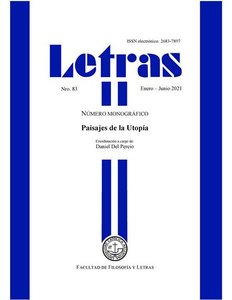Por favor, use este identificador para citar o enlazar este ítem:
https://repositorio.uca.edu.ar/handle/123456789/12549| Título: | Cartografías de utopía, o cómo leer un mapa de un no-lugar en la modernidad temprana Cartographies of utopia, or how to read a map of nowhere In the early modern period |
Autor: | Martínez, Carolina | Palabras clave: | UTOPIA; CARTOGRAFIA; MODERNIDAD; RELATOS DE VIAJES; MAPAS | Fecha de publicación: | 2021 | Editorial: | Pontificia Universidad Católica Argentina. Facultad de Filosofía y Letras | Cita: | Martínez, C. Cartografías de utopía, o cómo leer un mapa de un no-lugar en la modernidad temprana [en línea]. Letras. 2021, (83). doi: 10.46553/LET.83.2021.p21-37. Disponible en: https://repositorio.uca.edu.ar/handle/123456789/12549 | Resumen: | Resumen: El artículo indaga sobre la presencia de imágenes cartográficas en relatos
de viaje imaginarios producidos en la modernidad temprana europea. Para ello analiza
los mapas que acompañaron las ediciones de 1516 y 1518 de Utopía, la versión
realizada por Abraham Ortelius hacia 1595 y aquel incluido en la Histoire du Grand et
Admirable Royaume d’Antangil, publicada en la ciudad francesa de Saumur en 1616. El
texto reconfirma que, más allá del carácter imaginario o mimético de cualquier mapa, es
el contexto enunciativo el que habilita su “correcta” lectura. A la vez, sostiene que tanto
los mapas ficticios temprano-modernos cuanto el género utópico fueron ejercicios de
extrañamiento representativos del período en cuestión. Abstract: This article examines the presence of cartographic images in a set of imaginary travel accounts produced in early modern Europe. In order to do so, it analyzes the maps included the 1516 and 1518 editions of Utopia, the map of Utopia done by Abraham Ortelius in 1595 and the map included in the Histoire du Grand et Admirable Royaume d'Antangil, published in the French city of Saumur in 1616. The article reconfirms that, whether imaginary or mimetic in character, it is the map’s enunciative context that enables its “correct” reading. At the same time, the article argues that both the early-modern fictional map and the utopian genre were the product of operations of estrangement representative of that historical period. |
Cobertura Temporal: | SIGLO XVII SIGLO XVI |
URI: | https://repositorio.uca.edu.ar/handle/123456789/12549 | ISSN: | 0326-3363 (impreso) 2683-7897 (online) |
Disciplina: | LITERATURA | DOI: | 10.46553/LET.83.2021.p21-37 | Derechos: | Acceso abierto | Fuente: | Letras. 2021, (83) |
| Aparece en las colecciones: | LETRAS - 2021 nro. 83 - Paisajes de la Utopía |
Ficheros en este ítem:
| Fichero | Descripción | Tamaño | Formato | |
|---|---|---|---|---|
| 1eba5b74-5f76-4622-a12c-a3d0a4ee98a5.jpeg | 26,57 kB | JPEG |  Visualizar/Abrir | |
| cartografías-utopía-cómo-leer.pdf | 1,53 MB | Adobe PDF |  Visualizar/Abrir |
Visualizaciones de página(s)
173
comprobado en 27-abr-2024
Descarga(s)
347
comprobado en 27-abr-2024
Google ScholarTM
Ver en Google Scholar
Altmetric
Altmetric
Este ítem está sujeto a una Licencia Creative Commons

